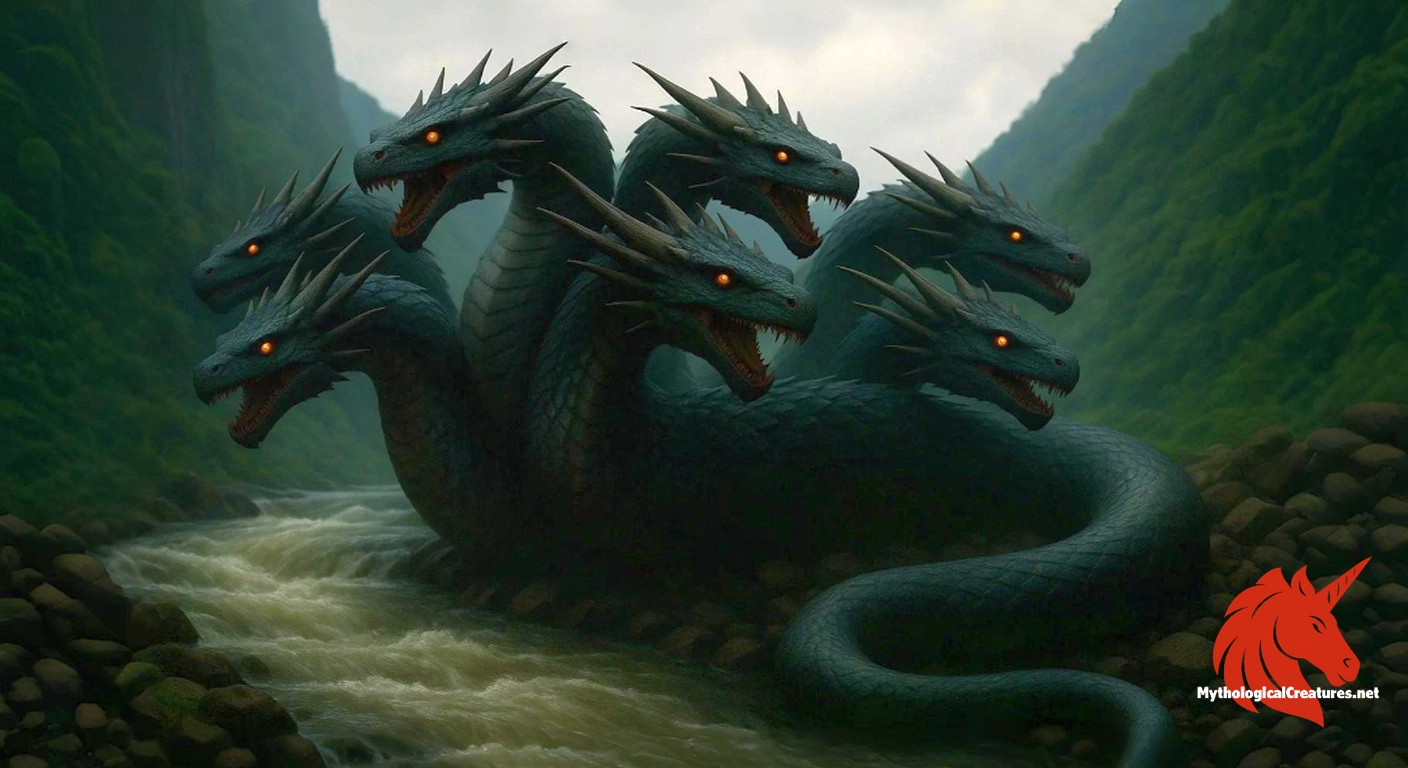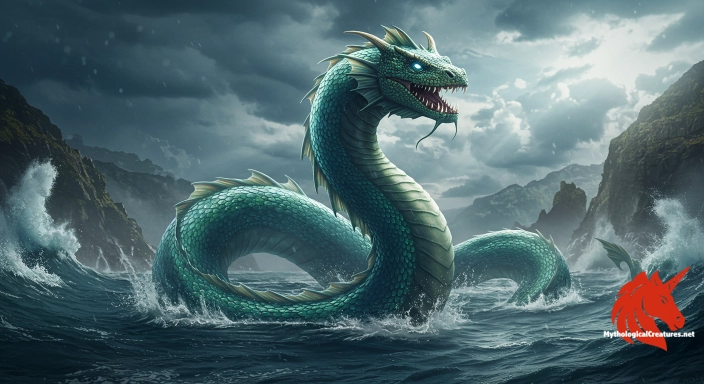Kulshedra: Kulshedra is a formidable, multi-headed serpentine demon from Albanian mythology known for her mastery over water, fire, and storms.

Kulshedra
Kulshedra - Embodies the dualistic struggle between chaos and order, darkness and light, and represents natural disasters as well as cosmic renewal
Origins & First Encounters
The Kulshedra emerges as a fearsome figure within Albanian mythology and folklore, embodying a complex duality that intertwines natural chaos with cosmic order. It is traditionally portrayed as a colossal, multi‐headed female serpentine dragon whose dominion over water, fire, storms, and chthonic energies defies mortal comprehension. In myth, she stands as the archetype of darkness and malevolence, artfully contrasting the benevolent drangue who represents light and goodness. Her origins are steeped in ancient ritual and oral tradition, where the forces of nature are both revered and feared. Stories recount her dramatic arrival during tempests and seismic disturbances, suggesting that her presence heralds both calamity and renewal. The myth symbolises an eternal battle between destructive power and the restoring forces of nature. Local legends detail her role in unleashing droughts, floods, and earthquakes as part of a cosmic struggle to maintain balance. Her presence in folklore has been passed down through generations, continuously inspiring awe and dread. Early attestations appear in varied regional accounts that emphasise her formidable attributes, while later interpretations add layers of symbolic meaning. Ultimately, the Kulshedra remains a potent emblem of the unpredictable forces that govern life and the eternal interplay between light and darkness.
Source Texts & Tale Variants
Ancient oral traditions, regional folktales, and allegorical texts create a rich tapestry of sources that detail the saga of the Kulshedra. Many of these narratives depict her as a terrifying multi‐headed serpent, whose evolution from a lesser demonic form known as the bolla to the mighty Kulshedra is meticulously chronicled. Early stories are interwoven with accounts of heroic figures—such as the drangue, the celestial daughter of the Moon and Sun, and even characters like Zjermi—who challenge her destructive might. Variations in the myth reflect the diverse ways in which local communities have interpreted natural disasters and cosmic battles. Some versions highlight her association with elemental forces, from raging storms to parching droughts, while others focus on her shape‐shifting ability. Written and oral sources alike emphasise her role in demanding human sacrifices to stave off calamity, lending a ritualistic aspect to her legend. The motif of her transformative journey—from the bolla to the fully developed Kulshedra—reveals a progression that is both metaphysical and symbolic. In many retellings, the creature’s offspring, known as Shlligë, add further intrigue by spreading disruptive storms. The varied story variants not only illustrate regional differences but also underscore the universality of themes such as chaos, renewal, and cosmic order. Each rendition contributes unique details that have enriched her myth over centuries of cultural transmission.
Form & Powers
The Kulshedra is most commonly depicted as a massive, multi‐headed serpentine dragon whose form exudes both lethal power and mystical allure. Her elongated, sinuous body is typically covered in shimmering scales that can evoke the colours of deep water and burning fire, reflecting her mastery over contrasting elements. Each of her many heads is rendered with distinctive, fearsome features, some capable of breathing fire while others seem to exude an eerie, cold mist. Her eyes, seldom described in detail, are often envisioned as deep-set and glimmering with an ancient, inscrutable wisdom that is both mesmerizing and daunting. Variations in her anatomy are notable; some accounts suggest that her vast form is large enough to encircle entire landscapes or even the world itself. Detailed descriptions sometimes liken her rugged, armour-like scales to the textures found in both aquatic creatures such as eels and the sturdy carapace of a turtle. In certain portrayals, she adopts the guise of a human woman, concealing her true monstrous nature behind a deceptive beauty. The interplay of fluid, serpentine curves and brutal, multi-faceted strength underscores her role as a symbol of nature’s unpredictable power. Every head and scale is imbued with symbolism, representing the multifarious forces of chaos and renewal that she commands. Through intricate visual detail, the Kulshedra’s portrayal invites the observer to consider the timeless balance between creation and destruction.
Regional Faces
The depiction of the Kulshedra varies significantly across different Albanian regions and neighbouring cultural landscapes. In the northern traditions, she is sometimes credited with the uncanny ability to capture and manipulate celestial bodies such as the sun and moon, enhancing her reputation as a being of both terror and mystique. Meanwhile, southern narratives often portray her as an immense serpent that encircles the world—a symbolic representation of impending cosmic upheaval. Local adaptations introduce unique elements, such as variations in the number of her heads and differing ritual requirements like specific counts of human sacrifices. In some villages, her earlier form as the bolla is emphasised, highlighting a transformative journey that adapts to regional spiritual beliefs. This adaptability is further seen in accounts where she is depicted as resembling not only a traditional dragon but also creatures such as a frog, lizard, or even a salamander. The nuances in her portrayal tend to reflect the immediate environmental challenges and cultural concerns of each community. Such regional variations illustrate how the myth of the Kulshedra is continuously reshaped to both explain and influence local natural phenomena and societal rituals.
Cultural Parallels
The myth of the Kulshedra is deeply interwoven with the universal theme of cosmic struggle between order and chaos—a narrative thread that spans many cultures and mythologies. Her epic confrontations with heroic figures echo the classical Chaoskampf motif found in Indo-European traditions, where a divine warrior battles a monstrous serpentine adversary. Comparable legends include the Greek Hydra, the Babylonian Tiamat, and the Norse Jörmungandr, each representing similar forces of primordial chaos. Her multiple heads and elemental powers resonate with iconic dragon myths, reinforcing common symbolic elements such as destruction, rebirth, and inevitable balance. The dual nature of her persona, capable of both inflicting devastation and inadvertently fostering prosperity within her own domain, mirrors the paradoxes found in many mythic systems. Through these parallels, the Kulshedra reflects humanity’s long-standing engagement with nature’s unpredictable forces. This comparative framework not only highlights similarities but also allows for a deeper appreciation of how different cultures process the tension between creation and destruction. The shared imagery across myths underscores a collective human response to the mysteries of the natural world and the struggle for cosmic order. In aligning her narrative with these classical figures, her myth gains both depth and a universal appeal. Ultimately, the Kulshedra functions as a compelling symbol that bridges diverse mythological traditions, emphasising the global resonance of the eternal battle between light and darkness.
Legacy & Modern Evolution
Over time, the perception of the Kulshedra has evolved from a solely malevolent demon to a multifaceted symbol that embodies both destruction and renewal. Early folklore emphasised her as an omnipotent harbinger of natural disasters, demanding appeasement through elaborate sacrifices and ritualistic practices. As cultural narratives matured, her role was reinterpreted to reflect a deeper cosmic balance, incorporating the idea that destruction can pave the way for regeneration. This evolution parallels a broader shift in societal attitudes toward nature, where even calamitous forces are seen as integral to the cycles of life. In modern times, the Kulshedra has found new expression in literature, art, and popular media, often symbolising environmental flux and the unpredictable character of natural forces. Creative reinterpretations have cast her in both tragic and cautionary roles, exploring themes of ecological imbalance and the human impact on nature. Festivals and local rituals continue to invoke her symbolism, celebrating both the fearsome and the life-affirming aspects of her legacy. Contemporary storytellers harness her myth to comment on modern issues, from climate change to the fragility of human progress. The evolving narrative of the Kulshedra thus serves as a timeless reminder of the delicate balance between chaos and order, while her enduring presence bridges ancient myth with modern ecological consciousness. Through these layers of reinterpretation, she remains a captivating and relevant emblem of humanity’s ongoing dialogue with the forces of nature.
Interesting Fact
A unique aspect of Kulshedra’s lore is her transformative journey from the bolla stage to a multi-headed dragon, highlighting an evolving nature that mirrors the cycle of chaos and rebirth in mythology.
Quick Creature Info
Associations:
Our Mythic Legendary Rating:

Also Sometimes Known As:
Habitat:
Supernatural Powers:
Physical Attributes:
Abilities:
Behavior:
Lore:
Related Creatures, Tales or Lore
- HHydra
- LLadon
- JJörmungandr
References
Discover Another Mythical Legend You May Not Have Heard Of?
Uncover the mysteries of ancient folklore and expand your knowledge of legendary beings from cultures around the world.
Dare to Meet the Coi Coi-Vilu....
Mythical Disclaimer: The images and data on this site are derived from various historical and literary sources, but we have found that many myths often have multiple versions and interpretations across references, sometimes contradictory. As a result, these creature depictions are artistic interpretations—imaginative blends of folklore, legend, and a dash of AI guesswork. Because creature descriptions vary widely, our illustrations and accompanying information represent our best effort to honor mythology while bridging creative gaps. Enjoy these interpretations—just remember, we've done our best to respect the stories and validate available data, but in the realm of mythology, details often shift, imagination leads the way, and nothing is ever set in stone!
Curated by the Mythological Creatures Team (rev. May 2025)
